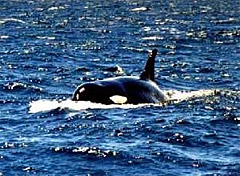 |
 |
 |
 Editorials | Environmental | March 2005 Editorials | Environmental | March 2005  
Whales Make A Comeback Off Mexico
 Mary Jordan - Washington Post Mary Jordan - Washington Post

The gray whales are back, jumping and splashing like 30-ton, sugar-buzzed schoolchildren in the luminous blue-green waters of this remote lagoon.


| According to the International Fund for Animal Welfare, Americans are the most avid whale watchers.

|
San Ignacio Lagoon, Mexico - Nearly hunted to extinction in the beginning of the 20th century, the whales have rebounded in numbers that are delighting government marine specialists who zip around this Pacific Ocean inlet in a 24-foot skiff, meticulously counting the lively mammals.

"It's looking very good this year," said Gabriel Arturo Zaragoza, chief of the Mexican government's whale census, balancing in a boat with pen and paper in hand. "These gentle creatures are back."

Zaragoza said there are now nearly as many whales in this narrow lagoon as there are people living on its majestic desert shores. He recently counted more than 800 newborn whales or calves here and in a second lagoon nearby, on the west coast of the Baja Peninsula.

"So far this season, the numbers are running higher than last year," Zaragoza said, noting that last year was exceptional, too. Most significant is the growing crop of 1,000-pound baby whales. "It's a great sign," he said.

In 1970, after the population of gray whales had plummeted to fewer than 2,000, they were placed on the endangered-species list. But as whale hunting stopped and whale watching became popular, the numbers of gray whales that ply these Pacific waters rose so steadily that by 1994, they were taken off the endangered list.

Now, following a mysterious die-off around 2000 that left many whales stranded on beaches, the population is on the rise again. The US National Marine Fisheries Service estimates that more than 18,000 gray whales migrate between Alaska and Mexico.

"It's exciting to see. We are happy about the bigger numbers," said Diane Alps of the American Cetacean Society. She said some authorities refer to whales as the "canaries of the sea," because - like canaries in a coal mine - when they are thriving, it generally indicates healthy conditions in their environment, in this case the ocean.

The gray whales are known as friendly whales because they tend to stay closer to shore and are the easiest to see. As their numbers have risen, so have the throngs turning out to see them. Marine officials report ever-growing crowds of whale watchers lining piers or filling boats off the Pacific coast of Canada, the United States, and Mexico during the viewing season.

According to the International Fund for Animal Welfare, Americans are the most avid whale watchers, but the pastime has grown rapidly in many parts of the world and is now a $1 billion industry spanning 87 countries, up from 31 in 1991. While only about 2,000 visitors came to Mexico to see whales in 1991, the fund said that by the late 1990s more than 100,000 were arriving.

Local residents said the arrival of the graybacks, which generally begin showing up in December and start leaving in March, was once a frightening nuisance. But that view changed as their numbers increased, and as many fisherman started earning far more money operating whale-watching tours than selling scallops and sea bass.

"How things have changed!" said Maria Luisa Camacho, who lives in an old fishing village on the lagoon. Fifteen years ago, she said, perhaps five visitors knocked on the door of her modest home, inquiring about the whales splashing outside her kitchen window.

They wanted to pay her husband to take them out in his tiny fishing boat for a closer look at the 40-foot-long mammals. Today she is accommodating 600 whale watchers, who stay in her rustic cabins, part of an expanding local whale-watching business called Antonio's EcoTours. | 
 | |
 |



